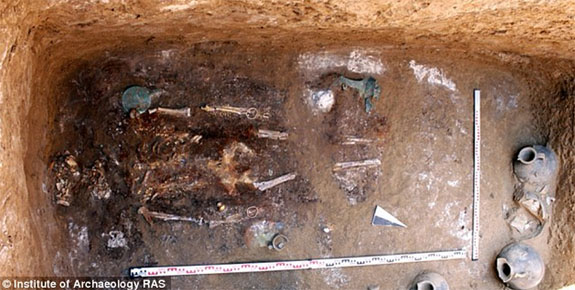Russian archaeologists recently discovered the 2,000-year-old grave of a female warrior, who apparently had an affection for elaborate gold and gemstone jewelry.

Presumed to be a noblewoman of Sarmatian origin, the warrior was discovered in an undisturbed burial mound near Rostov-on-Don in southern Russia near the Black Sea. In the tomb was a treasure trove of precious items, including dangling gold earrings, gold bracelets and a large gemstone inscribed in Aramaic.

The collar of her dress was decorated with stamped buckles of gold leaf in the form of a stylized ram's head and her sleeves were embroidered with colorful beads spaced with gold triangular and half-round plaques. She was buried with a large bronze mirror and a gold vial that possibly contained incense. The contents of the vial fossilized centuries ago, but will be analyzed by scientists.

Also found in her tomb, however, were symbols of her fighting heritage: a sword, knives, 100 iron arrowheads, and a horse's harness — possibility reflecting her equestrian prowess. An analysis of the woman's teeth revealed she lived to an old age and apparently survived many battles.

The noblewoman shared this burial mound with a man, who is assumed to be her husband. His part of the grave was looted and only fragments of crockery and bones remained.
The grave, which was protected with a wooden decking, was found at a depth of 13 feet. All of the items in the grave were dated from the first century BC to the first century AD.
The nomadic Sarmatian people, who worshipped fire, were of Iranian heritage and moved from Central Asia to the Ural Mountains between the 6th and 4th centuries BC. The archaeologists from the Russian Academy of Sciences' Institute of Archaeology believe their subject was Sarmatian because of the high status women held in that society.
The burial mound was one of 28 discovered during the construction of a new airport serving Rostov-on-Don. The other burials mounds had been looted long ago.
Archaeologist Roman Mimokhod told the Daily Mail, "Most of the burials on this site are plundered and, of course, it is great luck to find an intact one."
Credit: Images courtesy of the Russian Institute of Archaeology.
No comments:
Post a Comment